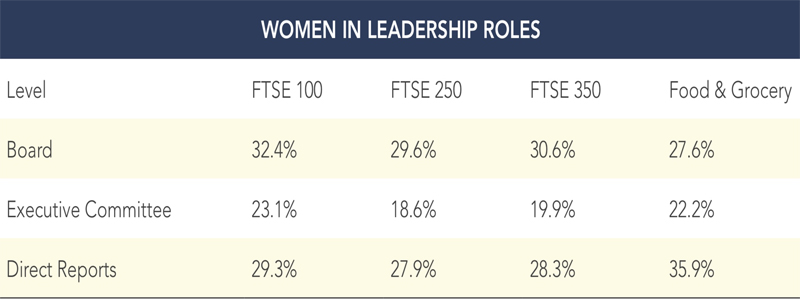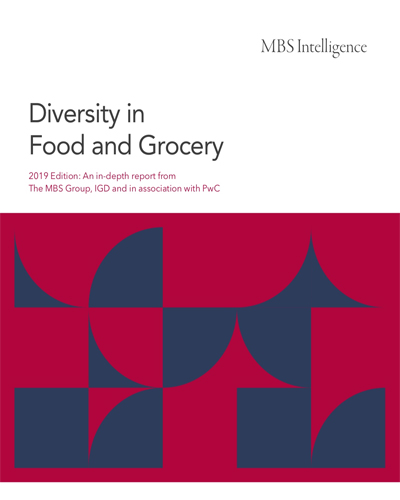The vast majority of companies in the food and grocery industry (84%) believe they are performing better today than they were five years ago on diversity and inclusion (D&I), according to new research launched yesterday by research and training charity IGD, executive search firm The MBS Group and PwC.
Yet fewer than half (45%) have adopted a co-ordinated D&I strategy, reveals the industry’s ‘first-of-its-kind’ Diversity in Food and Grocery report. Despite a genuine desire to do more across the industry, there is a ‘reluctance to talk more openly about D&I’, the report notes.
“Studies have shown that more diverse and inclusive workplaces have a higher level of employee engagement, are more productive and are more profitable,” says Susan Barratt, CEO of IGD. “The response and interest in this project from across our industry has been fantastic; there’s no doubt much is happening at an individual business level as well as collaboratively. However, this research also clearly demonstrates there is a need – and an appetite – to do a lot more.”
The research, which draws on data captured from over 200 companies and conversations with more than 100 Chairs, CEOs and HR Directors, aims to ‘paint a true picture’ of D&I in the industry, to highlight some examples of how a number of organisations are driving greater diversity in practice.
GENDER & BAME DATA
Regarding gender equality in the sector, an average of 27.6% of Board roles are occupied by women, the research reveals. At Executive Committee level this drops to 22.2%, while 35.9% of Direct Reports (into the Executive Committee) are women. Compared with the latest Hampton-Alexander Review figures, the food and grocery sector is ahead of the FTSE 350 cross-industry average at the Executive Committee and Direct Reports levels, but is unlikely to reach the Hampton-Alexander target of 33% women by the end of 2020.

That said, amongst the Direct Reports community, the industry is already above the 33% target. This demonstrates that if companies adopt the right approach, there is a strong pool of talent that can rise up to the Executive Committee and, over time, Board level roles, notes IGD.
On a positive note, the median gender pay gap within the food and grocery industry is lower than the UK economy as a whole (6.8% versus 9.6%), according to analysis by PwC. However, fewer than 10% of companies surveyed are prepared for ethnicity pay gap reporting if it is introduced in the coming years.
The percentage of Board members in the food and grocery industry from a BAME background (11.4%) is ‘very close to reflecting the UK working age population at large’ (12.5%), according to IGD. Some 5.7% of Executive Committee members and 7.1% of Direct Reports are BAME. Most companies do not collect complete data around ethnic diversity, however, “it is clear that there is a wide discrepancy at a company-by-company level. Nearly half of businesses have no BAME representation at the Direct Reports level, and 83% of companies have no BAME representation on their Executive Committees”, notes IGD.
The report also found that ‘nationality’ is sometimes confused with ‘ethnicity’. In the context of a looming labour shortage and the UK’s changing relationship with the EU, this could be a useful lever for improving productivity, suggests IGD. Across a sample of 50 companies across the food and grocery industry, 82% of Executive Committee members are British, compared to an average of 73% across the FTSE 350. Of the remaining Executive Committee members, there is a strong bias towards EU nationals (13% versus 5% of nationals of non-EU countries).

LEADERSHIP DATA
The average age of Board members in food and grocery is 57 years old, reveals the report. This is slightly below the average across the FTSE 350 of 60 years old. The average age of Executive Committee members is 54, which is in line with the FTSE 350 firms. With an ageing population, it’s now common for businesses to have three generations within the same teams, while constantly evolving advances in digital and technology are resulting in companies looking to new talent pools and reskilling existing employees to meet the challenge.
When asked to consider their wider senior leadership teams, only 27% of respondents were able to identify an openly LGTBQ+ leader within their business. As most companies do not collect data on LGBTQ+, it is difficult to measure how accurately this industry’s workforce reflects wider society. The most common approach to the LGBTQ+ agenda is to focus on promoting an inclusive working environment, often by working with outside not-for-profit organisations, the report reveals. Around 15% of respondents were able to identify someone with a physical disability, although no one was identified at the Executive Committee level, despite 19% of the working age population having a disability. Again, most companies do not collect data on disability, but the approach to physical disability tends to be more reactive than proactive, says IGD.
PROMOTING SOCIAL MOBILITY
Nearly 70% of respondents believe that the food and grocery sector is one of the best industries for promoting social mobility, with two-thirds of companies in the sector reporting that they are taking ‘active steps to encourage it’. Measuring success is difficult, the report notes. As well as lack of data in most companies, there is also a lack of clarity around how to define social mobility and what indicators individual companies can realistically assess progress against.
Commenting on the research results, IGD’s CEO Susan Barratt stated: “The progress that has been made in gender equality and the wide range of initiatives already in place to nurture female talent is particularly encouraging. But there are other levers of diversity beyond gender that can also help to create a diverse workforce – age, ethnicity, LGBTQ, social mobility and disability, amongst others. The research shows there is much more to do in these areas, to help businesses unlock new sources of talent for the future. IGD will continue to champion this important topic and make sure it stays high on our industry’s agenda.”
STRONG D&I BUSINESS CASE
While the case for diversity and inclusion is strong in all business sectors, “it’s especially so in an industry like food and grocery, where the customer reigns supreme,” noted Jon Terry, People and Organisation Consulting Partner, PwC UK. “What’s clear from businesses that are making the strongest progress on diversity is that this requires the same board-level direction, organisation-wide push, understanding of the data and regular reporting, intervention and incentives that would be applied to any other strategic priority. In short, diversity and inclusion need to be a part of an organisation’s strategy and its cultural DNA.”

Adding to his comments, Elliott Goldstein, Managing Partner of The MBS Group, commented: “Food and grocery is very much a data-led sector. It is our hope and belief that by providing our sector with a snapshot of diversity today, the findings will enable organisations to benchmark themselves against their peer group, and adjacent sectors/industries, and to act as a catalyst to change and development. The food and grocery industry can be proud of the progress is it has made to date changing the dial in diversity, but with just 22.2% of Executive Committee members being women, it is clear that as a sector there is still some way to go.”
As well as data to help businesses benchmark their progress, the report includes case studies from Arla foods, Coca-Cola European Partners, the Kellogg Company, Procter & Gamble, Sainsbury’s, Tesco, Tulip, and William Grant and Sons.
Click here for a copy of the Diversity in Food and Grocery report.







































